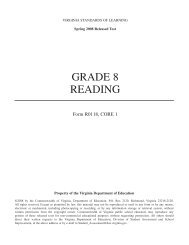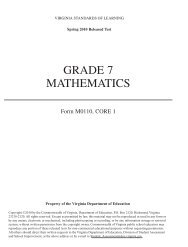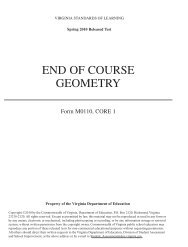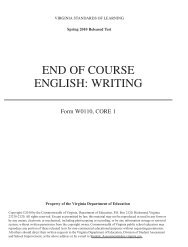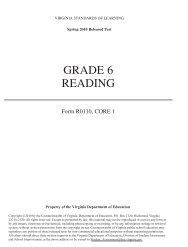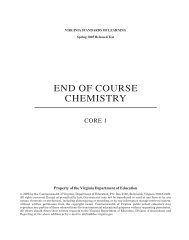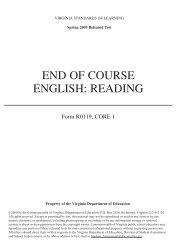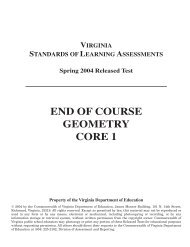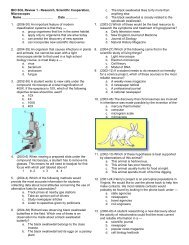2002 - SolPass
2002 - SolPass
2002 - SolPass
Create successful ePaper yourself
Turn your PDF publications into a flip-book with our unique Google optimized e-Paper software.
SESSION: 176 PAGE: 1 4/20/102 6:31 LOGIN IS-pam PATH: @sun1/xydisk2/CLS_psycorp/GRP_virginia/JOB_537152g11/DIV_g11rdg-1<br />
VIRGINIA<br />
STANDARDS OF LEARNING ASSESSMENTS<br />
Spring <strong>2002</strong> Released Test<br />
END OF COURSE<br />
ENGLISH:<br />
Reading/Literature and Research
SESSION: 176 PAGE: 2 4/20/102 6:31 LOGIN IS-pam PATH: @sun1/xydisk2/CLS_psycorp/GRP_virginia/JOB_537152g11/DIV_g11rdg-1<br />
Property of the Virginia Department of Education<br />
<strong>2002</strong> by the Commonwealth of Virginia Department of Education, James Monroe<br />
Building, 101 N. 14th Street, Richmond, Virginia, 23219. All rights reserved. Except<br />
as permitted by law, this material may not be reproduced or used in any form or by<br />
any means, electronic or mechanical, including photocopying or recording, or by any<br />
information storage or retrieval system, without written permission from the<br />
copyright owner. Commonwealth of Virginia public school educators may photocopy or<br />
print any portion of these Released Tests for educational purposes without requesting<br />
permission. All others should direct their requests to the Commonwealth of Virginia<br />
Department of Education at (804) 225-2102, Division of Assessment and Reporting.
SESSION: 179 PAGE: 3 4/23/102 14:42 LOGIN IS-pam PATH: @sun1/xydisk2/CLS_psycorp/GRP_virginia/JOB_537152g11/DIV_g11rdg-1<br />
English: Reading/Literature and Research<br />
DIRECTIONS<br />
Read each passage. Then read each question about the passage. Decide which is the best answer to each<br />
question. Mark the space on your answer sheet for the answer you have chosen.<br />
RYSAL131<br />
<br />
C<br />
SAMPLE<br />
Salmon Run<br />
No one has taught them how to struggle up<br />
On this, a run of grueling, flogging odds.<br />
Instinctive wisdom and a will to rise<br />
Suspends their forms against the crashing flood.<br />
5 Nothing can defeat the pounding roar as<br />
Enraged waters battle their advance.<br />
Clinging by a hidden will they climb,<br />
Stubborn, tireless, faithful as a dream.<br />
Ascending higher regions of the stream.<br />
RX05C102<br />
A<br />
What does this poem describe?<br />
B Lines 8 and 9 utilize —<br />
R903B449<br />
A<br />
Depression<br />
F<br />
end rhyme <br />
B<br />
Punishment<br />
G<br />
slant (approximate) rhyme<br />
C<br />
Regret<br />
H<br />
internal rhyme<br />
D<br />
Determination <br />
J<br />
alliteration<br />
<strong>2002</strong> Commonwealth of Virginia Department of Education<br />
3
SESSION: 179 PAGE: 4 4/23/102 14:42 LOGIN IS-pam PATH: @sun1/xydisk2/CLS_psycorp/GRP_virginia/JOB_537152g11/DIV_g11rdg-1<br />
Directions: Read the speech and answer the questions that follow.<br />
Susan B. Anthony Argues for Women’s Rights<br />
Susan B. Anthony<br />
RYSUS507<br />
<br />
C<br />
Susan Brownell Anthony fought for women throughout the nineteenth century in an effort to<br />
gain equal voting rights, pay, and education. Her words of protest were met with heated<br />
reactions; however, this response did not daunt Anthony. She organized the National Woman<br />
Suffrage Association to further the cause of women’s voting rights but was arrested for the<br />
crime of voting in 1872 when she led a group of women to the polls to cast ballots in the<br />
presidential election. Her courtroom speech, reprinted below, was published by newspapers<br />
nationwide in 1872.<br />
1 Friends and fellow citizens, I stand before you tonight under indictment for the alleged crime of<br />
having voted at the last presidential election, without having a lawful right to vote. It shall be my<br />
work this evening to prove to you that in thus voting, I not only committed no crime but, instead,<br />
simply exercised my citizen’s rights, guaranteed to me and all United States citizens by the<br />
National Constitution, beyond the power of any state to deny.<br />
2 The preamble of the federal Constitution says:<br />
“We, the people of the United States, in order to form a more perfect union, establish justice,<br />
insure domestic tranquility, provide for the common defense, promote the general welfare, and<br />
secure the blessings of liberty to ourselves and our posterity, do ordain and establish this<br />
Constitution for the United States of America.”<br />
3 It was we, the people; not we, the white male citizens; nor yet we, the male citizens; but we, the<br />
whole people, who formed the Union. And we formed it, not to give the blessings of liberty, but to<br />
secure them; not to the half of ourselves and the half of our posterity, but to the whole people —<br />
women as well as men. And it is a downright mockery to talk to women of their enjoyment of the<br />
blessings of liberty while they are denied the use of the only means of securing them provided by<br />
this democratic-republican government — the ballot.<br />
4 For any state to make sex a qualification that must ever result in the disfranchisement of one<br />
entire half of the people is to pass a bill of attainder, or an ex post facto law, and is therefore a<br />
violation of the supreme law of the land. By it the blessings of liberty are forever withheld from<br />
women and their female posterity. To them this government has no just powers derived from the<br />
consent of the governed. To them this government is not a democracy. It is not a republic. It is an<br />
odious aristocracy; a hateful oligarchy 1 of sex; the most hateful aristocracy ever established on the<br />
face of the globe; an oligarchy of wealth, where the rich govern the poor. An oligarchy of learning,<br />
where the educated govern the ignorant, . . . might be endured; but this oligarchy of sex, which<br />
makes father, brothers, husband, sons, the oligarchs over the mother and sisters, the wife and<br />
daughters, of every household — which ordains all men sovereigns, all women subjects, carries<br />
dissension, discord, and rebellion into every home of the nation.<br />
5 Webster, Worcester, and Bouvier all define a citizen to be a person in the United States, entitled to<br />
vote and hold office.<br />
6 The only question left to be settled now is: Are women persons? And I hardly believe any of our<br />
opponents will have the hardihood to say they are not. Being persons, then, women are citizens;<br />
and no state has a right to make any law, or to enforce any old law, that shall abridge their<br />
privileges or immunities. Hence, every discrimination against women in the constitutions and<br />
laws of the several states is today null and void, precisely as is every one against Negroes.<br />
1 oligarchy - a state governed by a few persons<br />
[Public Domain]<br />
<strong>2002</strong> Commonwealth of Virginia Department of Education<br />
4
SESSION: 179 PAGE: 5 4/23/102 14:42 LOGIN IS-pam PATH: @sun1/xydisk2/CLS_psycorp/GRP_virginia/JOB_537152g11/DIV_g11rdg-1<br />
R903D532<br />
<br />
C<br />
R903D531<br />
<br />
C<br />
R903D533<br />
<br />
C<br />
1 This speech conveys all the following<br />
messages except that the author —<br />
A<br />
B<br />
C<br />
D<br />
is upset over the attitudes of the times<br />
wants equality for all<br />
wants to enter politics <br />
is knowledgeable of government affairs<br />
2 Susan B. Anthony cleverly offers the<br />
best evidence for her cause by —<br />
F<br />
G<br />
H<br />
J<br />
quoting “We the people” as written in<br />
the Constitution <br />
opening with “Friends and fellow<br />
citizens . . .”<br />
referring to democracy as “an oligarchy<br />
of sex”<br />
stating that “all men sovereigns, all<br />
women subjects”<br />
3 “Webster, Worcester, and Bouvier all<br />
define a citizen to be a person in the<br />
United States, entitled to vote and hold<br />
office.”<br />
In paragraph 5, Anthony cites the<br />
common definitions of the word<br />
“citizen” in order to —<br />
A<br />
B<br />
C<br />
D<br />
show these authors agree with her<br />
position<br />
prove she has done her research on the<br />
subject<br />
use accepted definitions to prove her<br />
point <br />
illustrate that every citizen is a person<br />
in the United States<br />
4 Anthony’s outrage at women’s lack of<br />
equal rights is most forcefully<br />
expressed in which of these<br />
statements?<br />
F<br />
G<br />
H<br />
J<br />
The whole people formed the union to<br />
secure the blessings of liberty for men<br />
and women.<br />
To make sex a qualification will result<br />
in disfranchisement of one entire half of<br />
the people.<br />
It is a downright mockery to talk to<br />
women of their enjoyment of the<br />
blessings of liberty. <br />
No state has the right to make any law,<br />
or enforce any old law, that shall<br />
abridge privileges.<br />
5 This selection is an example of<br />
persuasive argument because it —<br />
A<br />
B<br />
C<br />
D<br />
presents an opposing point of view <br />
is written in first-person point of view<br />
relates a personal experience<br />
refers to a historical document<br />
6 Susan B. Anthony’s speech gains<br />
support for her cause by clearly<br />
reflecting —<br />
F<br />
G<br />
H<br />
J<br />
her wish to gain personal notoriety<br />
her frustration with the white, male<br />
attitude <br />
her frustration with women who don’t<br />
wish to vote<br />
her wish to make public speeches<br />
7 Which major American literature<br />
theme is captured in this selection?<br />
R903D547<br />
<br />
C<br />
R903A515<br />
<br />
C<br />
R903D549<br />
<br />
C<br />
A<br />
B<br />
C<br />
D<br />
Rebellion and protest <br />
Searching for scientific progress<br />
Honoring the historical past<br />
Disillusionment with self<br />
RY03E502<br />
<br />
C<br />
<strong>2002</strong> Commonwealth of Virginia Department of Education<br />
5
SESSION: 179 PAGE: 6 4/23/102 14:42 LOGIN IS-pam PATH: @sun1/xydisk2/CLS_psycorp/GRP_virginia/JOB_537152g11/DIV_g11rdg-1<br />
Directions: Read the poem and answer the questions that follow.<br />
To an Athlete Dying Young<br />
A. E. Housman<br />
RYATH514<br />
<br />
C<br />
The time you won your town the race<br />
We chaired you through the market-place;<br />
Man and boy stood cheering by,<br />
And home we brought you shoulder-high.<br />
5 Today, the road all runners come,<br />
Shoulder-high, we bring you home,<br />
And set you at your threshold down,<br />
Townsman of a stiller town.<br />
Smart lad, to slip betimes 1 away<br />
10 From fields where glory does not stay<br />
And early though the laurel grows<br />
It withers quicker than the rose.<br />
Eyes the shady night has shut<br />
Cannot see the record cut,<br />
15 And silence sounds no worse than cheers<br />
After earth has stopped the ears:<br />
Now you will not swell the rout<br />
Of lads that wore their honors out,<br />
Runners whom renown outran<br />
20 And the name died before the man.<br />
So set, before its echoes fade,<br />
The fleet foot on the sill of shade,<br />
And hold to the low lintel up<br />
The still-defended challenge-cup.<br />
25 And round that early-laureled head<br />
Will flock to gaze the strengthless dead,<br />
And find unwithered on its curls<br />
The garland briefer than a girl’s.<br />
Reprinted with permission of The Society of Authors as the literary representative of the Estate<br />
of A. E. Housman.<br />
1 betimes - archaic form of “soon”<br />
<strong>2002</strong> Commonwealth of Virginia Department of Education<br />
6
SESSION: 179 PAGE: 7 4/23/102 14:42 LOGIN IS-pam PATH: @sun1/xydisk2/CLS_psycorp/GRP_virginia/JOB_537152g11/DIV_g11rdg-1<br />
RX05C525<br />
<br />
C<br />
R903E511<br />
<br />
C<br />
8 Which statement best paraphrases<br />
lines 11-12 from “To an Athlete Dying<br />
Young”?<br />
“And early though the laurel grows<br />
It withers quicker than the rose.”<br />
F<br />
G<br />
H<br />
J<br />
Success in early life is almost always<br />
overshadowed by success in later life.<br />
The older a person gets, the less he or<br />
she cares about winning.<br />
A laurel wreath lasts longer than a<br />
garland of roses.<br />
An early victory usually fades away and<br />
is forgotten as the victor ages. <br />
9 In the first two stanzas the carrying<br />
home of the athlete “shoulder-high”<br />
suggests the idea of —<br />
A<br />
B<br />
C<br />
D<br />
death<br />
defeat<br />
honor <br />
sorrow<br />
11 In “To an Athlete Dying Young” the<br />
poet inspires a sense of reverence for<br />
the deceased athlete by his use of —<br />
A<br />
B<br />
C<br />
D<br />
direct quotations from friends<br />
rosemary as a symbol<br />
memories of his victory <br />
description of his burial<br />
12 In Housman’s poem, he mentions laurel,<br />
which is used in Roman mythology.<br />
Which source would prove most useful<br />
to understand the Roman mythology<br />
mentioned in A. E. Housman’s poetry?<br />
F<br />
G<br />
H<br />
J<br />
The New World Atlas of Ancient Rome<br />
Princeton Encyclopedia of Poetry and<br />
Poetics<br />
The Anatomy of Criticism<br />
Classic References in 20th Century<br />
English Poetry <br />
RX05B518<br />
<br />
C<br />
RY09B540<br />
<br />
C<br />
RX05A515<br />
<br />
C<br />
10 Describe the rhyme scheme used by<br />
the poet in “To an Athlete Dying<br />
Young.”<br />
F<br />
G<br />
H<br />
J<br />
abca<br />
aabb <br />
abba<br />
abab<br />
13 Which of these images is not used by<br />
the poet to allow the reader to<br />
understand a sense of loss?<br />
A<br />
B<br />
C<br />
D<br />
the victory march through town<br />
the laurel wreath<br />
the gold medal <br />
the still-defended challenge-cup<br />
R903D546<br />
<br />
C<br />
<strong>2002</strong> Commonwealth of Virginia Department of Education<br />
7
SESSION: 179 PAGE: 8 4/23/102 14:42 LOGIN IS-pam PATH: @sun1/xydisk2/CLS_psycorp/GRP_virginia/JOB_537152g11/DIV_g11rdg-1<br />
R903A503<br />
<br />
C<br />
R903B511<br />
<br />
C<br />
14 The first stanza contains examples of —<br />
F<br />
G<br />
H<br />
J<br />
paired couplets <br />
blank verse<br />
internal rhyme<br />
free verse<br />
15 Which line from the poem contains an<br />
example of paradox?<br />
A<br />
B<br />
C<br />
D<br />
Line 15 —“And silence sounds no worse<br />
than cheers” <br />
Line 24 —“The still-defended<br />
challenge-cup.”<br />
Line 26 —“Will flock to gaze the<br />
strengthless dead,”<br />
Line 28 —“The garland briefer than a<br />
girl’s.”<br />
16 The speaker communicates the<br />
townspeople’s love for the athlete<br />
through which lines?<br />
F Lines 1-2 “The time you won your<br />
town the race<br />
We chaired you through<br />
the market-place;” <br />
G Lines 9-10 “Smart lad, to slip betimes<br />
away<br />
From fields where glory<br />
does not stay”<br />
H Lines 17-18 “Now you will not swell<br />
the rout<br />
Of lads that wore their<br />
honors out,”<br />
J Lines 21-22 “So set, before its echoes<br />
fade,<br />
The fleet foot on the sill of<br />
shade,”<br />
R903D548<br />
<br />
C<br />
17 This poem and others like it would<br />
most likely be found in which of these<br />
sources?<br />
A<br />
B<br />
C<br />
D<br />
Contemporary Literary Criticism<br />
The St. Martin’s Guide to Writing<br />
A Handbook to Poetic Terms<br />
The Norton Anthology of Modern<br />
Poetry <br />
RY09B503<br />
<br />
C<br />
<strong>2002</strong> Commonwealth of Virginia Department of Education<br />
8
SESSION: 179 PAGE: 9 4/23/102 14:42 LOGIN IS-pam PATH: @sun1/xydisk2/CLS_psycorp/GRP_virginia/JOB_537152g11/DIV_g11rdg-1<br />
RYRID541<br />
<br />
C<br />
Directions: Read the passage and answer the questions that follow.<br />
Riding Is an Exercise of the Mind<br />
N. Scott Momaday<br />
1 One autumn morning in 1946, I woke up at Jémez Pueblo. I had arrived there in the middle of the<br />
night and gone to sleep. I had no idea of the landscape, no sense of where in the world I was. Now,<br />
in the bright New Mexican morning, I began to look around and settle in. I had found the last,<br />
best home of my childhood.<br />
2 When my parents and I moved to Jémez, I was twelve years old. The world was a different place<br />
then, and Jémez was the most exotic corner within it. The village and the valley, the canyons and<br />
the mountains had been there from the beginning of time, waiting for me. So it seemed. Marco<br />
Polo in the court of Kublai Khan had nothing on me. I was embarked upon the greatest adventure<br />
of all; I had come to the place of my growing up.<br />
3 The landscape was full of mystery and of life. The autumn was in full bloom. The sun cast a golden<br />
light upon the adobe walls and the cornfields; it set fire to the leaves of willows and cottonwoods<br />
along the river; and a fresh cold wind ran down from the canyons and carried the good scents of<br />
pine and cedar smoke, of bread baking in the beehive ovens, and of rain in the mountains. There<br />
were horses in the plain and angles of geese in the sky.<br />
4 One November, on the feast of San Diego, Jémez took on all the colors of a Renaissance Fair. I<br />
lived on the southwest corner of the village, on the wagon road to San Ysidro. I looked southward<br />
into the plain; there a caravan of covered wagons reached as far as the eye could see. These were<br />
the Navajos, coming in from Torreón. I had never seen such a pageant; it was as if that whole,<br />
proud people, the Diné, had been concentrated into one endless migration. There was a great<br />
dignity to them, even in revelry. They sat tall in the wagons and on horseback, going easily with<br />
laughter and singing their riding songs. And when they set up camp in the streets, they were<br />
perfectly at home, their dogs about them. They made coffee and fried bread and roasted mutton on<br />
their open fires.<br />
5 Gradually and without effort I entered into the motion of life there. In the winter dusk I heard<br />
coyotes barking away by the river, the sound of the drums in the kiva, and the voice of the village<br />
crier, ringing at the rooftops.<br />
6 I came to know the land by going out upon it in all seasons, getting into it until it became the very<br />
element in which I lived my daily life.<br />
7 I had a horse named Pecos, a fleet-footed roan gelding, which was my great glory for a time. Pecos<br />
could outrun all the other horses in the village, and he wanted always to prove it. We two came to<br />
a good understanding of each other, I believe. I did a lot of riding in those days, and I got to be very<br />
good at it. My Kiowa ancestors, who were centaurs, should have been proud of me.<br />
8 Riding is an exercise of the mind. I dreamed a good deal on the back of my horse, going out into<br />
the hills alone. Desperados were everywhere in the brush. More than once I came upon roving<br />
bands of hostile Indians and had, on the spur of the moment, to put down an uprising. Now and<br />
then I found a wagon train in trouble, and always among the settlers there was a lovely young girl<br />
from Charleston or Philadelphia who needed simply and more than anything else in the world to<br />
be saved. I saved her.<br />
9 After a time Billy the Kid was with me on most of those adventures. He rode on my right side and<br />
a couple of steps behind. I watched him out of the corner of my eye, for he bore watching. We got<br />
on well together in the main, and he was a good man to have along in a fight. We had to be careful<br />
of glory-seeking punks. Incredibly there were those in the world who were foolish enough to<br />
oppose us, merely for the sake of gaining a certain reputation.<br />
<strong>2002</strong> Commonwealth of Virginia Department of Education<br />
9
SESSION: 179 PAGE: 10 4/23/102 14:42 LOGIN IS-pam PATH: @sun1/xydisk2/CLS_psycorp/GRP_virginia/JOB_537152g11/DIV_g11rdg-1<br />
10 When it came time for me to leave home and venture out into the wider world, I sold my horse to<br />
an old gentleman at Vallecitos. I like to think that Pecos went on with our games long afterwards,<br />
that in his old age he listened for the sound of bugles and of gunfire — and for the pitiful weeping<br />
of young ladies in distress — and that he heard them as surely as I do now.<br />
Copyright 1992 by N. Scott Momaday. From In the Presence of the Sun: Stories and Poems by N. Scott Momaday. Reprinted by<br />
permission of St. Martin’s Press, Inc.<br />
R903A202<br />
<br />
C<br />
18 This selection is best described as —<br />
F<br />
G<br />
H<br />
J<br />
a personal narrative <br />
a tall tale<br />
an editorial<br />
a satire<br />
21 When the author compares himself to<br />
Marco Polo in the court of Kublai<br />
Khan, he is using a historical —<br />
A<br />
B<br />
C<br />
D<br />
allusion <br />
argument<br />
benchmark<br />
misconception<br />
R903D203<br />
<br />
C<br />
R903D205<br />
<br />
C<br />
19 In the paragraphs about desperados<br />
and Billy the Kid, the author achieves<br />
most of his effect through the use of —<br />
A<br />
B<br />
C<br />
D<br />
extensive explanation<br />
imaginative narration <br />
philosophical insights<br />
amusing asides<br />
22 The comparison to Marco Polo in the<br />
court of Kublai Khan is intended to<br />
make readers feel the —<br />
F<br />
G<br />
H<br />
J<br />
tranquility of the scenery<br />
ruggedness of the mountain terrain<br />
difference between today’s world and the<br />
world of 1946<br />
author’s sense of awe at his new<br />
surroundings <br />
R903E203<br />
<br />
C<br />
20 Which of the following is the most<br />
important element in this selection?<br />
R903B204<br />
<br />
C<br />
F<br />
G<br />
H<br />
J<br />
The plot<br />
The setting <br />
The climax<br />
The characterization<br />
23 In this story, the narrator imagines<br />
himself to be —<br />
A<br />
B<br />
C<br />
D<br />
an outsider<br />
a hero <br />
a caretaker<br />
a trickster<br />
RY03D504<br />
<br />
C<br />
<strong>2002</strong> Commonwealth of Virginia Department of Education<br />
10
SESSION: 179 PAGE: 11 4/23/102 14:42 LOGIN IS-pam PATH: @sun1/xydisk2/CLS_psycorp/GRP_virginia/JOB_537152g11/DIV_g11rdg-1<br />
R903D238<br />
<br />
C<br />
24 In Greek mythology, a centaur is a<br />
creature who is half horse and half<br />
man. In paragraph 7, the narrator calls<br />
his ancestors centaurs. This reference<br />
suggests that they —<br />
F<br />
G<br />
H<br />
J<br />
were believed to be descended from<br />
horses<br />
had learned about Greek mythology<br />
looked mysterious on horseback<br />
were superb horsemen <br />
26 Which detail does not contribute to the<br />
reader’s perception that Jémez Pueblo<br />
is an exotic place?<br />
F<br />
G<br />
H<br />
J<br />
“The autumn was in full bloom.” <br />
“. . . the sound of the drums in the kiva,<br />
and the voice of the village crier . . .”<br />
“The sun cast a golden light upon the<br />
adobe walls and the cornfields . . .”<br />
“. . . of bread baking in the beehive<br />
ovens, and of rain in the mountains.”<br />
R903D239<br />
<br />
C<br />
R903C515<br />
<br />
C<br />
25 Which sentence from the selection best<br />
reveals the author’s attitude toward<br />
his subject?<br />
A<br />
“I lived on the southwest corner of the<br />
village . . .”<br />
B “I had never seen such a pageant . . .”<br />
C “There was a great dignity to them . . .”<br />
D<br />
“I was embarked upon the greatest<br />
adventure of all . . .” <br />
<strong>2002</strong> Commonwealth of Virginia Department of Education<br />
11
SESSION: 179 PAGE: 12 4/23/102 14:42 LOGIN IS-pam PATH: @sun1/xydisk2/CLS_psycorp/GRP_virginia/JOB_537152g11/DIV_g11rdg-1<br />
Directions: Read the research paper and answer the questions that follow.<br />
The following is a draft of a research paper written by an eleventh-grade student for his<br />
English class.<br />
Sebastian Samuels<br />
Mrs. Norton<br />
English-5<br />
5 October 2001<br />
Samuels 1<br />
RYPAT253<br />
<br />
C<br />
L<br />
Eudora Welty’s Use of Myth<br />
1 In her intriguing short story “A Worn Path,” Eudora Welty tells two<br />
tales, one having a literal sequence of events and another having a deeper,<br />
philosophical meaning. Read as a simple narrative, “A Worn Path” tells of an<br />
old woman who walks a great distance to obtain medicine for her chronically<br />
ill grandson. However, “by interweaving the account of this quest of love<br />
with the Egyptian Phoenix myth, the author provides the reader with a<br />
symbolic level of interpretation that not only adds texture and power to the<br />
tale but also reveals its theme of immortality” (Conners 33). We especially<br />
find this to be true when we examine the plot and character elements of the<br />
story.<br />
2 The use of the name “Phoenix” for the main character establishes the<br />
story’s connection to myth. In Well-Known Egyptian Myths, Adrian Phelps<br />
explains that Phoenix is also the name of a mythological bird that was sacred<br />
to the sun-god in ancient Egypt. Every 500 years, according to the myth, the<br />
bird creates a funeral pyre of its own nest and then rises from the ashes. In<br />
gathering the ashes and depositing them at the Temple of the Sun in<br />
Heliopolis, a sacred city in Egypt, “the magnificent Phoenix manifests its<br />
immortality” (82). The character of Old Phoenix Jackson embodies the<br />
Egyptian myth both physically and spiritually.<br />
3 How can an old woman resemble a mythological bird that has “brilliant<br />
scarlet and gold plumage” (Phelps 21)? In her vivid description of Phoenix<br />
Jackson, Welty writes that “a golden color ran underneath [her skin] and the<br />
two knobs of her cheeks were illuminated by a yellow burning under the dark.<br />
Under the big red rag, her hair came down ...”(1). In addition to this<br />
colorful image, Welty uses sound and movement to liken Old Phoenix to a bird.<br />
The tapping of Phoenix’s cane “seemed meditative like the chirping of a<br />
solitary little bird” (1). When the old woman walked, she moved “from side to<br />
side in her steps” (1). Even her head movements are reminiscent of those of a<br />
bird: “She ... shook her head once or twice in a little strutting way” (3).<br />
Details such as these create a bird-like impression of the human Phoenix.<br />
4 The woman’s symbolic connection with the mythical bird is also<br />
established through frequent allusions to birds. Welty refers to a mourning<br />
dove, a buzzard, some quail, and some dead bob-whites. She writes of pine<br />
cones that drop “as light as feathers” (2). She compares the way Old Phoenix<br />
picks up a nickel to “lifting an egg from under a sitting hen” (5); also, as<br />
Old Phoenix steals the nickel, a bird flies by and Old Phoenix experiences<br />
this as a symbol of God’s presence. Finally, the old woman remembers her<br />
grandson thus: “He ... peep out holding his mouth open like a little bird”<br />
(7).<br />
<strong>2002</strong> Commonwealth of Virginia Department of Education<br />
12
SESSION: 179 PAGE: 13 4/23/102 14:42 LOGIN IS-pam PATH: @sun1/xydisk2/CLS_psycorp/GRP_virginia/JOB_537152g11/DIV_g11rdg-1<br />
Samuels 2<br />
5 The journeys traveled by Old Phoenix Jackson and the mythological<br />
Phoenix are similar. Heliopolis and Natchez, their respective destinations,<br />
are both large cities that hold the keys to renewal and continued life. Both<br />
journeys are ritualistic in their cyclic repetition, the bird’s journey<br />
occurring every five centuries and the woman’s each time her grandson needs<br />
medicine. “The journeys of both the bird and the old woman symbolize the life<br />
cycle, an eternal walk of confusion until a destination is reached” (Paton<br />
20). Just as the mythological Phoenix transcends all nature in its<br />
extraordinary actions, Phoenix Jackson, driven by focused intent, moves<br />
beyond what might be considered the physical limitations of an old woman. As<br />
the Phoenix bird pauses during its journey, so does the old woman. The<br />
mythical bird resurrects itself “fresh and new” after its self-sacrifice in<br />
the nest (Conners 20). When resting, Phoenix Jackson “spread her skirts on the<br />
bank around her and folded her hands over her knees” (Welty 2), also assuming<br />
a nesting position.<br />
6 By associating her story “A Worn Path” with the ancient Egyptian Phoenix<br />
myth, Eudora Welty enriches a simple tale, raising it to a level of<br />
universality. We all re-create ourselves as we overcome challenges and<br />
defeats along the road of life.<br />
Works Cited<br />
Conners, Michael. “The Theme of Immortality in Eudora Welty’s Works.”<br />
Criticism of American Literature. Ed. Thomas C. Jones. Chicago:<br />
Ballentine, 1988. 3-37.<br />
Paton, Tonya. “Mythological Allusions in the Short Stories of Eudora<br />
Welty.” Literary Journal 19.3 (1991). 15-22.<br />
Phelps, Adrian. Well-Known Egyptian Myths. New York: Tantum, 1993.<br />
Welty, Eudora. “A Worn Path.” The Collected Stories of Eudora Welty. Ed.<br />
Susan James. Orlando: Harcourt, 1980: 1-7.<br />
Due to space constraints, some of the specifications of the style manual used (such as double-spacing and a<br />
separate page for citing works) have not been followed in this paper.<br />
<strong>2002</strong> Commonwealth of Virginia Department of Education<br />
13
SESSION: 179 PAGE: 14 4/23/102 14:42 LOGIN IS-pam PATH: @sun1/xydisk2/CLS_psycorp/GRP_virginia/JOB_537152g11/DIV_g11rdg-1<br />
27 In paragraph 2, the word embodies<br />
means —<br />
30 Which is a most likely thesis of this<br />
paper?<br />
RY04D207<br />
<br />
C<br />
L<br />
RY04D208<br />
<br />
C<br />
L<br />
A<br />
B<br />
C<br />
D<br />
represents <br />
narrates<br />
forgets<br />
encourages<br />
28 In paragraph 5, the word transcends<br />
means —<br />
F<br />
G<br />
H<br />
J<br />
passes through<br />
treasures<br />
goes beyond <br />
amazes<br />
F<br />
G<br />
H<br />
J<br />
In “A Worn Path,” Old Phoenix Jackson<br />
symbolizes immortality because she is<br />
an elderly person who still undertakes<br />
long journeys.<br />
“A Worn Path” is by far the most<br />
complex and interesting of all Eudora’s<br />
Welty’s short stories.<br />
Many writers use mythological<br />
references to make their stories more<br />
interesting.<br />
Eudora Welty used allusions to the<br />
ancient Egyptian Phoenix myth to<br />
deepen the significance of her short<br />
story “A Worn Path.” <br />
RY09B204<br />
<br />
C<br />
L<br />
RY09D205<br />
<br />
C<br />
L<br />
29 Sebastian shows that Eudora Welty<br />
presented Old Phoenix as bird-like<br />
by —<br />
A<br />
B<br />
C<br />
D<br />
comparing the purposes of their<br />
respective journeys<br />
posing questions about birds to the<br />
reader<br />
discussing the migrating habits of birds<br />
using specific descriptive examples from<br />
the story <br />
31 Which question does Sebastian not<br />
attempt to answer in this paper?<br />
A<br />
B<br />
C<br />
D<br />
In what ways does the character Old<br />
Phoenix Jackson physically resemble a<br />
bird?<br />
Who originally wrote down the Egyptian<br />
myth about the Phoenix bird? <br />
For what purpose is Old Phoenix<br />
Jackson traveling to the city of Natchez?<br />
Why did Eudora Welty use Phoenix as<br />
the name for the main character in “A<br />
Worn Path”?<br />
R904D204<br />
<br />
C<br />
L<br />
32 Sebastian primarily organized this<br />
paper by —<br />
F<br />
G<br />
H<br />
J<br />
listing a sequence of events from a<br />
fictional work<br />
suggesting several possible solutions to<br />
a problem<br />
drawing comparisons and supporting<br />
them with examples <br />
describing the life and personality of a<br />
famous author<br />
RX10A205<br />
<br />
C<br />
L<br />
<strong>2002</strong> Commonwealth of Virginia Department of Education<br />
14
SESSION: 179 PAGE: 15 4/23/102 14:42 LOGIN IS-pam PATH: @sun1/xydisk2/CLS_psycorp/GRP_virginia/JOB_537152g11/DIV_g11rdg-1<br />
33 In order to best appreciate the many<br />
levels of the short story “A Worn Path,”<br />
the reader would need to —<br />
R904A202<br />
<br />
C<br />
L<br />
A<br />
B<br />
C<br />
D<br />
be aware of certain facts from Eudora<br />
Welty’s life<br />
know about the Egyptian Phoenix myth <br />
know where the city of Natchez is<br />
located<br />
be familiar with all of Eudora Welty’s<br />
stories<br />
35 To find out how Eudora Welty used<br />
mythology in other stories, the reader<br />
should consult the cited source written<br />
by —<br />
A<br />
B<br />
C<br />
D<br />
Adrian Phelps<br />
Tonya Paton <br />
Michael Connors<br />
Eudora Welty<br />
RY09C206<br />
<br />
C<br />
L<br />
R904B205<br />
<br />
C<br />
L<br />
34 The reader could best evaluate the<br />
accurate use of information in this<br />
paper by reading —<br />
F<br />
G<br />
H<br />
J<br />
other Welty stories to see how they are<br />
organized<br />
the definition of the word “Phoenix” in a<br />
dictionary<br />
an encyclopedia entry about Eudora<br />
Welty<br />
the story and the myth that are<br />
discussed in the paper <br />
<strong>2002</strong> Commonwealth of Virginia Department of Education<br />
15
SESSION: 179 PAGE: 16 4/23/102 14:42 LOGIN IS-pam PATH: @sun1/xydisk2/CLS_psycorp/GRP_virginia/JOB_537152g11/DIV_g11rdg-1<br />
Directions: Read the passage and answer the questions that follow.<br />
Years Completed<br />
Major<br />
1 2 3 4 5 Degree<br />
Minor<br />
EMPLOYMENT APPLICATION<br />
POSITION APPLIED FOR<br />
DATE<br />
Tennis Instructor Aide June 11, 2001<br />
NAME<br />
DATE OF BIRTH<br />
SOCIAL SECURITY<br />
Nadine Beckley<br />
May 6, 1985 NUMBER 162-00-9177<br />
STREET AND NUMBER<br />
17 Conifer Drive<br />
RYEMP324<br />
CITY, STATE, AND ZIP CODE<br />
<br />
Forest Hills, Virginia 23219<br />
C<br />
HOME TELEPHONE NUMBER<br />
(888) 293-3151<br />
ArtCodes<br />
EDUCATION<br />
RYEMP324.AR1 NAME<br />
HIGH SCHOOL<br />
Did you<br />
If you did not graduate,<br />
Forest Hills High School<br />
Graduate?<br />
do you have a G.E.D. Certificate?<br />
LOCATION<br />
Forest Hills, Virginia<br />
YES<br />
YES<br />
Circle Grade Completed 1 2 3 4 5 6 7 8 9 1 0 11 12<br />
NO<br />
NO<br />
NAME<br />
COLLEGE<br />
Did you<br />
If you did not graduate,<br />
LOCATION<br />
Graduate?<br />
how many units did you complete?<br />
SKILLS<br />
PLEASE DESCRIBE THE SKILLS, KNOWLEDGE, AND ABILITY YOU HAVE ACQUIRED EITHER THROUGH EDUCATION OR EXPERIENCE<br />
THAT QUALIFY YOU FOR THE POSITION FOR WHICH YOU ARE APPLYING. (IF EXTRA SPACE IS NEEDED, ATTACH SEPARATE SHEET.)<br />
NOTE: Verification of citizenship is required prior to hiring. A criminal conviction does not automatically disqualify you for employment.<br />
The time and nature of the offense will be considered.<br />
According to Article 12, Section 816, National Fair Employment Law, an employer may not require any employee or applicant for employment<br />
to submit to a polygraph, lie detector, or similar test as a condition of employment. Any employer violating this provision is subject to a fine of<br />
up to $100.<br />
Please note that a NO-SMOKING policy is in effect in all of our offices and buildings except in specifically designated smoking areas.<br />
APPLICANT’S STATEMENT: All answers in this application are true and complete to the best of my knowledge. I understand that any<br />
false or misleading information will result in ineligibility for the position for which I am applying.<br />
Applicant’s Signature Nadine Beckley<br />
Date<br />
June 11, 2001<br />
PERSONNEL DEPARTMENT USE ONLY<br />
Required Legal Documents<br />
Birth Certificate<br />
Original Social Security Card Valid Driver’s License<br />
U.S. Military Card<br />
U.S. Passport<br />
Certificate of Citizenship Certificate of Naturalization Alien Registration Card<br />
CERTIFICATION: I attest that all documents presented to me by the above-named individual have been thoroughly examined and appear<br />
to be genuine.<br />
COMMENTS:<br />
YES<br />
NO<br />
Semester Units?<br />
Quarter Units?<br />
I have been playing tennis since I was 10 years old and have taken lessons for the past three<br />
years. I attended tennis camp for two summers, and last summer I helped my instructor with<br />
beginning students.<br />
Reviewer's Signature<br />
Date<br />
<strong>2002</strong> Commonwealth of Virginia Department of Education<br />
16
SESSION: 180 PAGE: 17 4/23/102 14:46 LOGIN IS-pam PATH: @sun1/xydisk2/CLS_psycorp/GRP_virginia/JOB_537152g11/DIV_g11rdg-1<br />
36 If this application were for a job<br />
working at a fast-food restaurant,<br />
which part would Nadine change?<br />
R904A303<br />
<br />
C<br />
F<br />
G<br />
H<br />
J<br />
Skills description <br />
Applicant’s statement<br />
Education information<br />
Legal specifications<br />
39 The section entitled PERSONNEL<br />
DEPARTMENT USE ONLY is the place<br />
where —<br />
A<br />
B<br />
C<br />
D<br />
comments of past employers are written<br />
a detailed job description is given<br />
the reviewer makes notes about the<br />
applicant <br />
the applicant signs and dates the<br />
document<br />
RY04B302<br />
<br />
C<br />
R904D304<br />
<br />
C<br />
37 Nadine Beckley’s description of her<br />
skills, knowledge, and ability answers<br />
all of these questions except which<br />
one?<br />
A<br />
B<br />
C<br />
D<br />
Do you have experience that might be<br />
helpful if you are hired for this position?<br />
Is this work something you think you<br />
would enjoy?<br />
Would you be qualified to handle a<br />
medical emergency on the job? <br />
Do you have experience interacting with<br />
other people in a work environment?<br />
40 According to this employment<br />
application, no employee can be<br />
required to —<br />
F<br />
G<br />
H<br />
J<br />
handle large sums of money<br />
submit to a lie detector test <br />
lift weights over 30 pounds<br />
operate a motor vehicle<br />
RX04E304<br />
<br />
C<br />
41 The last person to sign the application<br />
is the —<br />
R904D305<br />
<br />
C<br />
38 Which question is not asked on the<br />
application?<br />
F<br />
G<br />
H<br />
J<br />
What was your major area of study in<br />
college?<br />
Do you live with your parents? <br />
What is your social security number?<br />
Do you currently attend high school?<br />
<strong>2002</strong> Commonwealth of Virginia Department of Education<br />
17<br />
A<br />
B<br />
C<br />
D<br />
parent<br />
reviewer <br />
applicant<br />
tester<br />
42 If the applicant does not have enough<br />
room to list all skills and experiences<br />
for this job, which of these would be<br />
best to do?<br />
F<br />
G<br />
H<br />
J<br />
Attach a full resume to the application<br />
form<br />
Use a second application form for the<br />
“Skills” section only<br />
Write in the margins of the application<br />
form<br />
Attach a plain sheet of paper with<br />
applicable skills and experiences <br />
RX04C306<br />
<br />
C<br />
R904C518<br />
<br />
C
SESSION: 179 PAGE: 18 4/23/102 14:42 LOGIN IS-pam PATH: @sun1/xydisk2/CLS_psycorp/GRP_virginia/JOB_537152g11/DIV_g11rdg-1<br />
Test<br />
Sequence<br />
Correct<br />
Answer<br />
Reporting<br />
Category<br />
Answer Key<br />
Reporting Category Description<br />
1 C 002 Understand the elements of literature.<br />
2 F 002 Understand the elements of literature.<br />
3 C 002 Understand the elements of literature.<br />
4 H 002 Understand the elements of literature.<br />
5 A 002 Understand the elements of literature.<br />
6 G 002 Understand the elements of literature.<br />
7 A 002 Understand the elements of literature.<br />
8 J 002 Understand the elements of literature.<br />
9 C 002 Understand the elements of literature.<br />
10 G 002 Understand the elements of literature.<br />
11 C 002 Understand the elements of literature.<br />
12 J 003 Locate and use information from a variety of resource materials.<br />
13 C 002 Understand the elements of literature.<br />
14 F 002 Understand the elements of literature.<br />
15 A 002 Understand the elements of literature.<br />
16 F 002 Understand the elements of literature.<br />
17 D 003 Locate and use information from a variety of resource materials.<br />
18 F 002 Understand the elements of literature.<br />
19 B 002 Understand the elements of literature.<br />
20 G 002 Understand the elements of literature.<br />
21 A 002 Understand the elements of literature.<br />
22 J 002 Understand the elements of literature.<br />
23 B 002 Understand the elements of literature.<br />
24 J 002 Understand the elements of literature.<br />
25 D 002 Understand the elements of literature.<br />
26 F 002 Understand the elements of literature.<br />
27 A 001 Understand a variety of printed materials.<br />
28 H 001 Understand a variety of printed materials.<br />
29 D 003 Locate and use information from a variety of resource materials.<br />
30 J 003 Locate and use information from a variety of resource materials.<br />
31 B 001 Understand a variety of printed materials.<br />
32 H 003 Locate and use information from a variety of resource materials.<br />
33 B 001 Understand a variety of printed materials.<br />
34 J 001 Understand a variety of printed materials.<br />
35 B 003 Locate and use information from a variety of resource materials.<br />
36 F 001 Understand a variety of printed materials.<br />
37 C 001 Understand a variety of printed materials.<br />
38 G 001 Understand a variety of printed materials.<br />
39 C 001 Understand a variety of printed materials.<br />
40 G 001 Understand a variety of printed materials.<br />
41 B 001 Understand a variety of printed materials.<br />
42 J 001 Understand a variety of printed materials.




